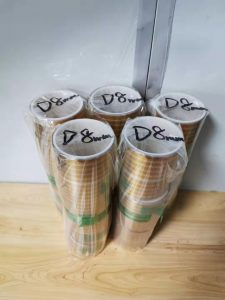Cinta KAPTON troquelada
xinst22 de mayo de 2020
La cinta de poliimida (Kapton Tape), también conocida como cinta de dedo de oro, se basa en una película de poliimida (película de oro) y utiliza adhesivo sensible a la presión de silicona importado, que tiene buena adherencia, buena adherencia, resistencia a ácidos y álcalis, resistencia a la radiación, alta temperatura resistencia, resistencia a disolventes, sin penetración de estaño, sin pegamento residual, sellado autoadhesivo, aislamiento eléctrico (Clase H), resistencia a la radiación, etc.

Polyimide tape (KAPTON) can be used for PCB gold finger protection, printed circuit board gold finger, tin pass furnace, motor, transformer, heating equipment, electrical insulation, lithium battery, hot air tin hole processing, shielding protection in various stages in tin furnace , Motor insulation, coil winding, shielding electromagnetic waves, anti-static, wire, cable, electromagnetic wire insulation, etc.
The specifications (thickness) of the polyimide tape produced by the company are: 0.05mm, 0.06mm, 0.08mm, 0.11mm, 0.12mm, etc., the length is 33M, and the width can be arbitrarily cut between 3mm and 500mm. Arbitrary shapes can be die cut from drawings and samples.
Polyimide has good dielectric properties, the dielectric constant is about 3.4, the introduction of fluorine, or the dispersion of air nano-size in polyimide, the dielectric constant can be reduced to about 2.5. Dielectric loss is 10-3, dielectric strength is 100-300KV / mm, Guangcheng thermoplastic polyimide is 300KV / mm, and volume resistance is 1017Ω / cm. These properties can be maintained at a high level in a wide temperature range and frequency range.
Polyimide can be polycondensed from dianhydride and diamine in a polar solvent such as DMF, DMAC, NMP or THE / methanol mixed solvent at low temperature to obtain soluble polyamic acid, and heated to It is dehydrated into a ring at about 300 ° C and converted into a polyimide; acetic anhydride and tertiary amine catalysts can also be added to the polyamic acid for chemical dehydration cyclization to obtain a polyimide solution and powder. Diamine and dianhydride can also be polycondensed by heating in a high boiling point solvent, such as phenolic solvent, to obtain polyimide in one step. In addition, polyimide can also be obtained by reacting the dibasic ester of tetrabasic acid with diamine; it can also be converted from polyamic acid to polyisoimide first, and then to polyimide. These methods are convenient for processing. The former is called PMR method, which can obtain low viscosity and high solid solution. There is a window with low melt viscosity during processing, which is especially suitable for the manufacture of composite materials; the latter is increased In order to improve the solubility, no low molecular compounds are released during the conversion process.

